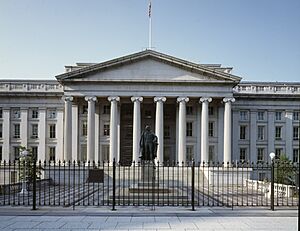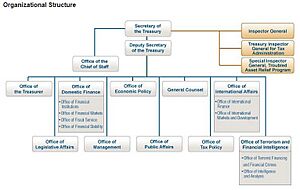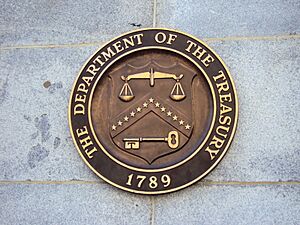United States Department of the Treasury facts for kids

|
|

|
|
 Treasury Building |
|
| Agency overview | |
|---|---|
| Formed | September 2, 1789 |
| Preceding agency |
|
| Type | Executive department |
| Jurisdiction | U.S. federal government |
| Headquarters | Treasury Building 1500 Pennsylvania Avenue, NW Washington, D.C., U.S 38°53′51.2″N 77°2′3.4″W / 38.897556°N 77.034278°W |
| Employees | 87,336 (2019) |
| Annual budget | $20.2 billion (2024) |
| Agency executives |
|
| Child agencies | |
The Department of the Treasury (often called USDT) is like the main money manager for the federal government of the United States. It's one of 15 important government groups. This department handles all the money matters for the country.
The Treasury Department is in charge of the Bureau of Engraving and Printing and the U.S. Mint. These two groups print all the paper money and make all the coins. The Treasury also makes sure money moves smoothly in the country. It collects all federal taxes through the Internal Revenue Service (IRS). It also manages the money the U.S. government owes. The department helps to license and watch over banks. It also gives advice to the government on how to handle money and the economy.
The main person in charge is the Secretary of the Treasury. This person is a member of the President's Cabinet. Another important role is the treasurer of the United States. This person advises the Secretary on things like making coins and paper money. You can see the signatures of both these officials on all Federal Reserve notes (our paper money).
The department was started by a law in 1789. Its job was to manage the government's money. The first Secretary of the Treasury was Alexander Hamilton. He was one of the Founding Fathers. President George Washington chose him for the job. Hamilton started the country's first financial system. He was a very important part of Washington's government.
People often just call it "Treasury" without saying "the" before it. This is a leftover from how things were said in British English. Alexander Hamilton's picture is on the front of the ten-dollar bill. The Treasury Building in Washington, D.C. is on the back.
Contents
Treasury Department History
American Revolution and Money
The idea for the Treasury Department started during the American Revolution. The Continental Congress met in Philadelphia. They needed to figure out how to pay for the war. The Thirteen Colonies wanted to be free from Great Britain.
The Congress could not collect taxes. It was also hard to get money from other countries. So, they decided to print paper money. They called these "bills of credit." They promised to exchange this paper money for real coins later. On June 22, 1775, the Congress printed $2 million in bills.
On July 29, 1775, the Second Continental Congress put George Clymer and Michael Hillegas in charge of the government's money. They were called Continental treasurers. Each colony was asked to give money to the government. As the country's debt grew, Congress created a committee of five people. Their job was to oversee the money. On April 1, 1776, a Treasury Office was set up. It helped manage money and keep records. After the Declaration of Independence was signed, the new country could get loans from other nations.
Even with loans, the colonies struggled to manage their money well. Michael Hillegas became the first Treasurer of the United States in 1777. The Treasury Office changed its structure three times between 1778 and 1781. The paper money they printed quickly lost its value. By May 1781, it was almost worthless. This led to the saying, "not worth a Continental."
Founding the Treasury Department
Robert Morris was put in charge of finances in 1781. He helped make the nation's money stable again. Morris was a rich merchant. People called him "the financier" because he was so good at finding money. He had a team that managed the country's money until 1784. After he left, a treasury board took over until 1789.
The First United States Congress met in New York City in 1789. On September 2, 1789, Congress created the Treasury Department. This was a permanent group to manage the government's money. The law said there would be a Secretary of the Treasury, a Comptroller, an Auditor, a Treasurer, and other officers.
Alexander Hamilton became the first Secretary of the Treasury on September 11, 1789. Hamilton had been a helper to George Washington during the war. He was very good with money and managing things. This made him a great choice to fix the new nation's large war debt. His first act was to tell Congress how to make the country financially healthy.
Hamilton believed the government should pay back all its $75 million debt. He said, "The debt of the United States was the price of liberty." He thought that paying debts would make people trust the government's money. He also thought the government should get money from customs duties (taxes on imported goods). His smart money plans also encouraged people to invest in the Bank of the United States. This bank helped the government handle its money.
The Treasury Department believes its seal was designed by Francis Hopkinson. He was the treasurer of loans. He created designs for other government seals too. The Treasury seal looks a lot like his other designs.
Important People in Treasury History
In 1861, Sophia Holmes became the first Black woman to work for the Treasury Department. She was hired as a janitor. In 1862, she found a box of over $200,000 in U.S. currency. She reported it to the Secretary.
President Abraham Lincoln praised her for her honesty. The government gave her a job for life as a messenger. Another early woman hired by the department was Jennie Douglas in 1862. She is sometimes said to be the first woman to hold an appointed job in the federal government.
What the Treasury Does

The main jobs of the Department of the Treasury include:
- Making all the paper money and coins for the U.S.
- Collecting taxes and other money owed to the U.S.
- Paying all the government's bills.
- Managing the country's money.
- Handling government bank accounts and the national debt.
- Watching over national banks and savings groups.
- Giving advice on money, trade, and tax rules.
- Making sure federal money and tax laws are followed.
- Finding and stopping tax evaders.
- Publishing reports with important numbers and facts.
From 1830 to 1901, the Treasury Department also oversaw weights and measures. This meant making sure that things like pounds and inches were standard. After 1901, this job went to another agency.
How the Treasury is Organized
The Treasury Department has two main parts. One part makes the big decisions and manages the whole department. The other part does the actual work.
Here are some of the main parts and leaders:
- The Secretary of the Treasury is the head.
- The Deputy Secretary helps the Secretary.
- The Treasurer of the United States advises on money and coins.
- The Bureau of Engraving and Printing prints paper money.
- The United States Mint makes coins.
- The Under Secretary for Domestic Finance deals with money matters inside the U.S.
- The Under Secretary for International Affairs handles money matters with other countries.
- The Under Secretary for Terrorism and Financial Intelligence works to stop money used for terrorism and crime.
- The Financial Crimes Enforcement Network (FinCEN) fights financial crimes.
- The Office of Foreign Assets Control (OFAC) enforces economic sanctions.
- The Commissioner of Internal Revenue leads the Internal Revenue Service (IRS).
- The IRS collects taxes.
- The Office of the Comptroller of the Currency oversees national banks.
- The Treasurer of the United States advises on money and coins.
- The Deputy Secretary helps the Secretary.
See also
 In Spanish: Departamento del Tesoro de los Estados Unidos para niños
In Spanish: Departamento del Tesoro de los Estados Unidos para niños
- Federal Reserve System
- MicroLoan Program
- Title 12 of the Code of Federal Regulations
- Title 17 of the Code of Federal Regulations
- Title 19 of the Code of Federal Regulations
- Title 31 of the Code of Federal Regulations
- Treasury Enterprise Architecture Framework
- Treasury Information System Architecture Framework
- United States Coast Guard History and Heritage Sites





